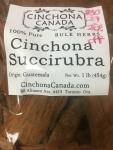Cinchona: Fever Tree aka Peruvian Bark Chunks, sold by the gram
Cinchona succirubra powder from Guatemala, sold by the gram, $.0833/g. Please bring or order a bag http://www.anarreshealth.ca/product/bag-biodegradable-reclosable-singles.
MAIL ORDERS & PRE ORDERS:
You must order a minimum of 100g and buy a bag http://www.anarreshealth.ca/product/bag-biodegradable-reclosable-singles or other suitable container (search JAR or BOTTLE on our website). You must allow us to package your bulk item in a container or bag that your item will fit in safely, and agree to pay any difference before you receive your item.
Order 453g and receive 20% off a 1 lb bag in refund or in store.
Cinchona has been historically sought after for its medicinal value, as the bark of several species yields quinine and other alkaloids that were the only effective treatments against malaria during the height of European colonialism, which made them of great economic and political importance.
Common Uses: People use the bark to make medicine. Cinchona is used for increasing appetite; promoting the release of digestive juices; and treating bloating, fullness, and other stomach problems. It is also used for blood vessel disorders including hemorrhoids, varicose veins, and leg cramps. Some people use cinchona for mild influenza, swine flu, the common cold, malaria, and fever. Other uses are for cancer, mouth and throat diseases, enlarged spleen, and muscle cramps.
Cinchona is used in eye lotions to numb pain, kill germs, and as an astringent. Cinchona extract is also applied to the skin for hemorrhoids, ulcers, stimulating hair growth, and managing varicose veins.
In foods, cinchona is used as a bitter flavouring in tonic water and alcoholic beverages.
IMPORTANT: IT IS POSSIBLE TO OVERDOSE, OR EXPERIENCE SIDE EFFECTS, FROM THE OVERUSE OR MISUSE OF CINCHONA. Please research its safe use for your purposes. https://www.nature.com/articles/s41477-020-0628-0
Traditional medicine
In herbalism, cinchona bark was used as an adulterant in Jesuit's bark or Peruvian bark which originally is thought to have referred to Myroxylon peruiferum, another fever remedy. Small strips are cut and various techniques such as "mossing", the application of moss to the cut areas, were used to allow the tree to heal. Other approaches involve coppicing and chopping of side branches which are then stripped of bark. The bark is dried into what were called quills and then powdered for medicinal uses. The bark contains alkaloids, including quinine and quinidine. Cinchona is the only economically practical source of quinine, a drug that is still recommended for the treatment of falciparum malaria.
Chemistry
General structure of Cinchona alkaloids
The bark of trees in this genus is the source of a variety of alkaloids, the most familiar of which is quinine, an antipyretic (antifever) agent especially useful in treating malaria.[46][47] For a while the extraction of a mixture of alkaloids from the cinchona bark, known in India as the cinchona febrifuge, was used. The alkaloid mixture or its sulphated form mixed in alcohol and sold quinetum was however very bitter and caused nausea, among other side effects.[48]
Cinchona alkaloids include:
cinchonine and cinchonidine (stereoisomers with R1 = vinyl, R2 = hydrogen)
quinine and quinidine (stereoisomers with R1 = vinyl, R2 = methoxy)
dihydroquinine and dihydroquinidine (stereoisomers with R1 = ethyl, R2 = methoxy)
They find use in organic chemistry as organocatalysts in asymmetric synthesis.
Other chemicals
Alongside the alkaloids, many cinchona barks contain cinchotannic acid, a particular tannin, which by oxidation rapidly yields a dark-coloured phlobaphene[49] called red cinchonic,[50] cinchono-fulvic acid, or cinchona red.[51]
In 1934, efforts to make malaria drugs cheap and effective for use across countries led to the development of a standard called "totaquina" proposed by the Malaria Commission of the League of Nations. Totaquina required a minimum of 70% crystallizable alkaloids, of which at least 15% was to be quinine with not more than 20% amorphous alkaloids.[52][53]
History
Carl Linnaeus named the genus in 1742 based on a claim that the plant had cured the wife of the Count of Chinchón, a Spanish viceroy in Lima, in the 1630s, though the veracity of this story has been refuted.
Of course, the curative properties of cinchona were known much earlier. Certain fever cures from South America known as Jesuit's bark and Jesuit's powder have been traced to Cinchona, there is also evidence of ingredients derived from other species such as Myroxylon.
The name quina-quina or quinquina was suggested as an old name for cinchona used in Europe and based on the native name used by the Quechua people. Qina and Jesuit's bark actually referred to Myroxylon peruiferum, or Peruvian balsam, Over time, the bark of Myroxylon may have been adulterated with the similar-looking bark of what we now know as Cinchona. Gradually the adulterant became the main product that was the key therapeutic ingredient used in malarial therapy.
Inspiration for Homeopathy
The birth of homeopathy was based on cinchona bark testing. The founder of homeopathy, Samuel Hahnemann, when translating William Cullen's Materia medica, noticed Cullen had written that Peruvian bark was known to cure intermittent fevers. Hahnemann took daily a large, rather than homeopathic, dose of Peruvian bark. After two weeks, he said he felt malaria-like symptoms. This idea of "like cures like" was the starting point of his writings on homeopathy. Hahnemann's symptoms have been suggested by researchers, both homeopaths and skeptics, as being an indicator of his hypersensitivity to quinine.



